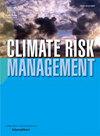Factors affecting the application of protective measures before flood occurrence among local communities in Iran
IF 5
2区 环境科学与生态学
Q1 ENVIRONMENTAL SCIENCES
引用次数: 0
Abstract
Floods rank among the most destructive natural hazards, inflicting extensive damage on rural areas by compromising infrastructure, destroying crops, and undermining livelihoods. Beyond the immediate economic losses, such events often trigger rural outmigration and erode social cohesion. Effective flood prevention strategies are therefore critical and can be advanced through public awareness campaigns, the reinforcement of social capital, the development of flood-resilient infrastructure, and the implementation of integrated crisis management plans. Despite the importance of these measures, previous research has largely concentrated on assessing community vulnerability, with limited attention given to proactive protective factors. Addressing this gap, the present study aims to identify the determinants influencing the adoption of protective measures among rural communities in Iran prior to flood events. The statistical population of this study comprised all rural households in Shushtar County, located in Khuzestan Province, southwest Iran. A sample of 353 rural household heads was selected using the Krejcie and Morgan table, applying a multi-stage stratified sampling method to ensure representation across different villages. Data were collected through a structured questionnaire, the validity of which was confirmed by a panel of subject matter experts, while reliability was assessed using Cronbach’s alpha coefficient. Data analysis was conducted in two phases—descriptive and inferential statistics—using SPSS and SmartPLS software. The findings demonstrated that the variables of psychological distance, social media use, place attachment, flood experience, social capital, and flood risk perception had significant and positive effects on protective behaviors prior to flooding. Collectively, these variables accounted for 76.3% of the variance in protective measures. These findings offer critical insights for policymakers seeking to enhance the resilience and safety of rural communities in flood-prone regions. By proactively addressing flood risks, such measures can contribute to the sustainability of rural livelihoods and the strengthening of local resilience.
影响伊朗当地社区在洪水发生前采取保护措施的因素
洪水是最具破坏性的自然灾害之一,通过破坏基础设施、摧毁作物和破坏生计,对农村地区造成广泛破坏。除了直接的经济损失外,这类事件往往引发农村人口外流,侵蚀社会凝聚力。因此,有效的防洪战略至关重要,可以通过提高公众意识、加强社会资本、发展抗洪基础设施以及实施综合危机管理计划来推进。尽管这些措施很重要,但以前的研究主要集中在评估社区脆弱性上,对主动保护因素的关注有限。为了解决这一差距,本研究旨在确定在洪水事件发生之前影响伊朗农村社区采取保护措施的决定因素。本研究的统计人口包括位于伊朗西南部胡齐斯坦省Shushtar县的所有农村家庭。采用Krejcie和Morgan表选取了353个农村户主样本,采用多阶段分层抽样方法,以确保不同村庄的代表性。数据通过结构化问卷收集,其有效性由主题专家小组确认,而可靠性则使用Cronbach 's alpha系数进行评估。使用SPSS和SmartPLS软件进行数据分析,分为描述性统计和推断性统计两个阶段。研究结果表明,心理距离、社交媒体使用、地方依恋、洪水经历、社会资本和洪水风险感知对洪水前保护行为有显著的正向影响。总的来说,这些变量占保护措施方差的76.3%。这些发现为寻求提高洪水易发地区农村社区的抗灾能力和安全性的政策制定者提供了重要的见解。通过积极应对洪水风险,这些措施有助于农村生计的可持续性和加强当地的抵御能力。
本文章由计算机程序翻译,如有差异,请以英文原文为准。
求助全文
约1分钟内获得全文
求助全文
来源期刊

Climate Risk Management
Earth and Planetary Sciences-Atmospheric Science
CiteScore
8.20
自引率
4.50%
发文量
76
审稿时长
30 weeks
期刊介绍:
Climate Risk Management publishes original scientific contributions, state-of-the-art reviews and reports of practical experience on the use of knowledge and information regarding the consequences of climate variability and climate change in decision and policy making on climate change responses from the near- to long-term.
The concept of climate risk management refers to activities and methods that are used by individuals, organizations, and institutions to facilitate climate-resilient decision-making. Its objective is to promote sustainable development by maximizing the beneficial impacts of climate change responses and minimizing negative impacts across the full spectrum of geographies and sectors that are potentially affected by the changing climate.
 求助内容:
求助内容: 应助结果提醒方式:
应助结果提醒方式:


